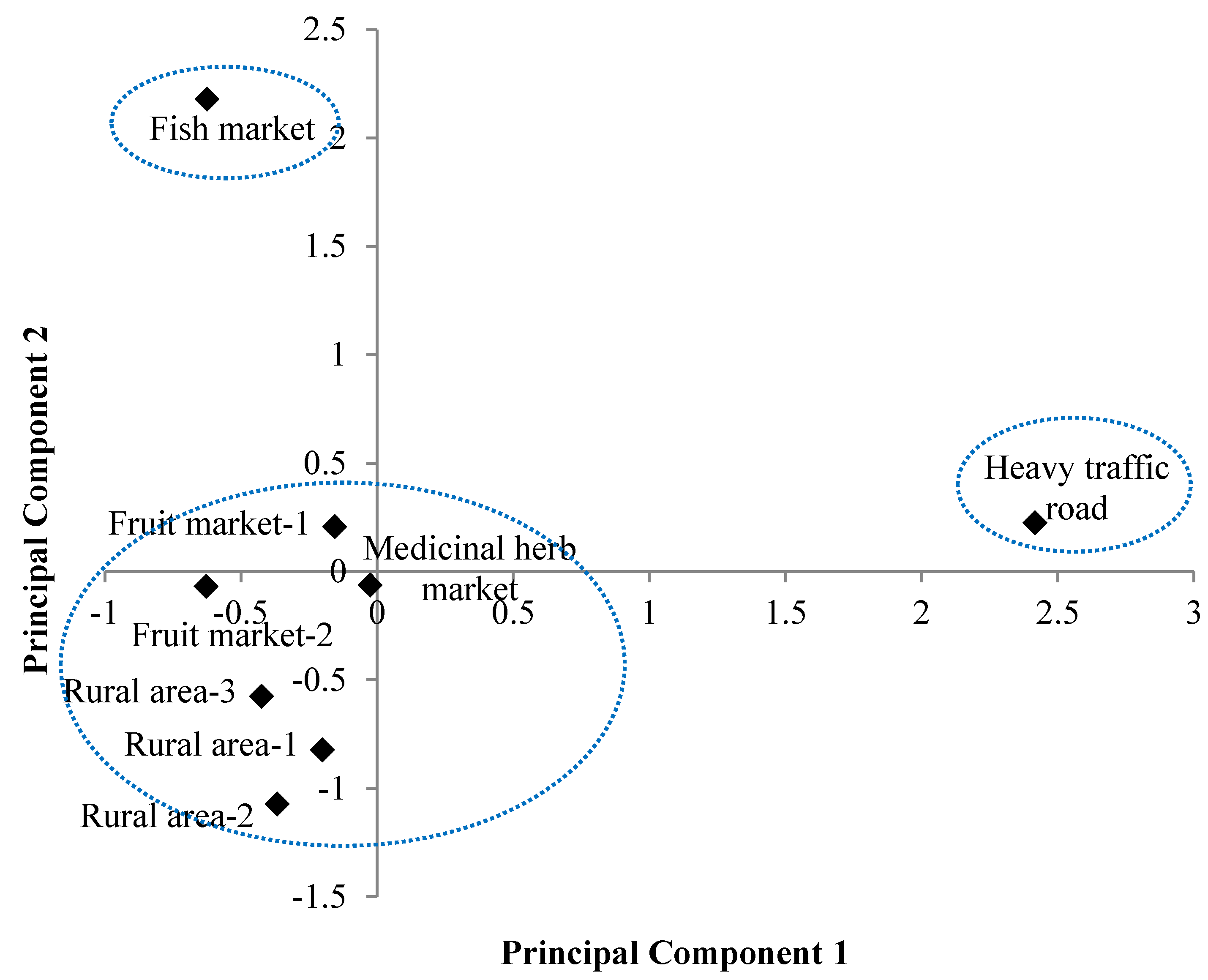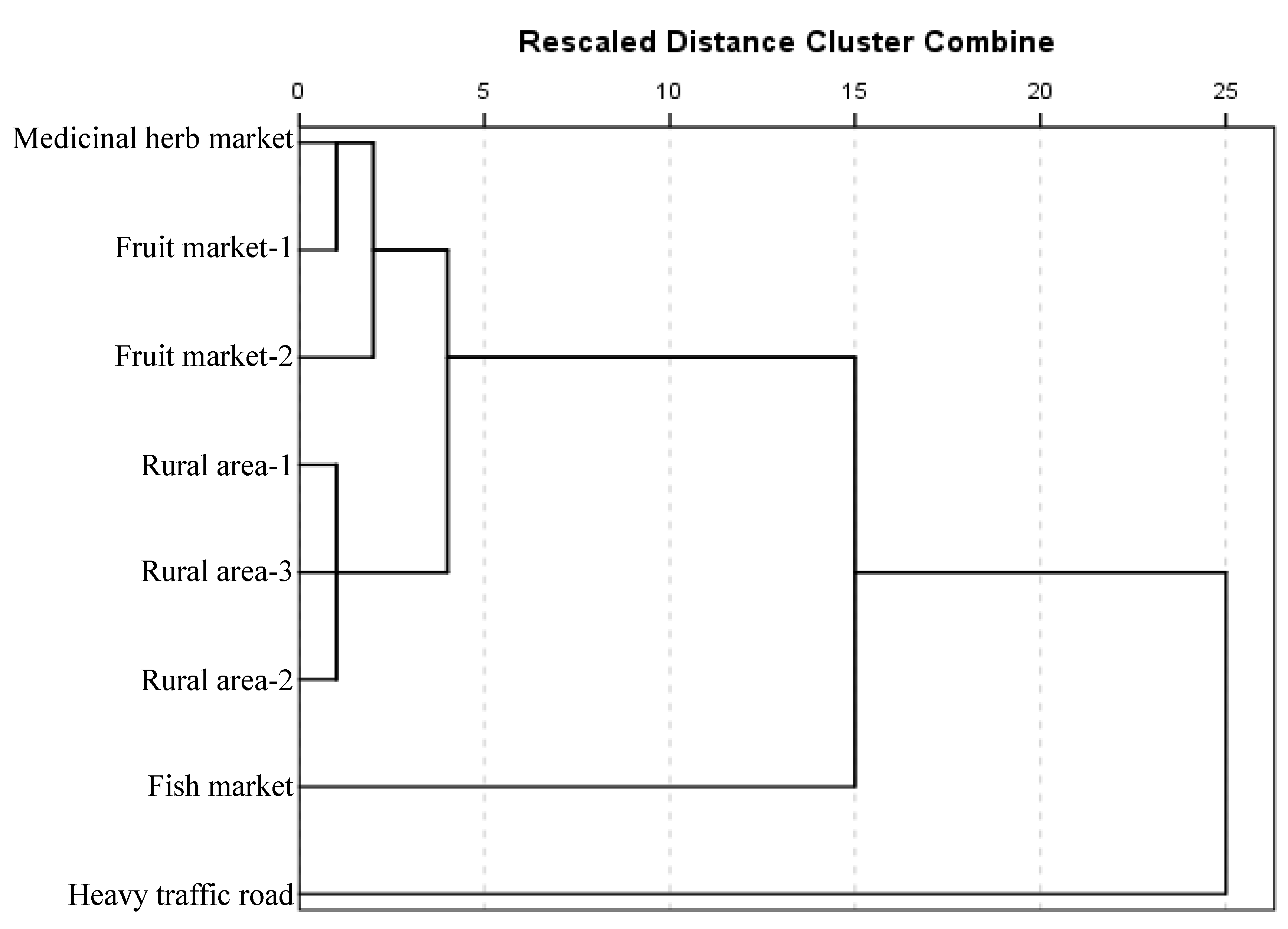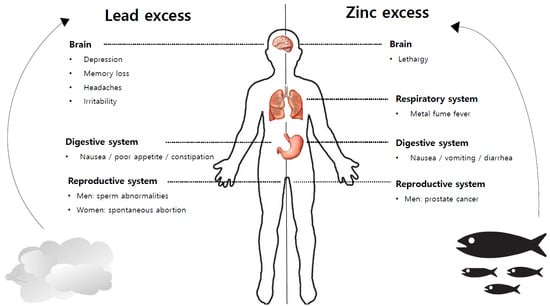Heavy Metal Distribution in Street Dust from Traditional Markets and the Human Health Implications
Abstract
:1. Introduction
2. Methods
2.1. Dust Sampling
2.2. Analysis of Dust Samples
2.3. Statistical Analysis of Heavy Metal Concentrations
2.4. Questionnaire Investigation
2.5. Statistical Analysis for Questionnaire Investigation
3. Results and Discussion
3.1. Total Elemental Concentrations
3.2. Enrichment Factors of Heavy Metals
3.3. Principal Component and Cluster Analyses
3.4. Relationship between Heavy Metal Concentration in Dust and Human Health
4. Conclusions
Acknowledgments
Author Contributions
Conflicts of Interest
References
- Akhter, M.S.; Madany, I.M. Heavy metals in street and house dust in Bahrain. Water Air Soil Pollut. 1993, 66. [Google Scholar] [CrossRef]
- Lu, X.; Wang, L.; Lei, K.; Huang, J.; Zhai, Y. Contamination assessment of copper, lead, zinc, manganese and nickel in street dust of Baoji, NW China. J. Hazard. Mater. 2009, 161, 1058–1062. [Google Scholar] [CrossRef] [PubMed]
- Zheng, N.; Liu, J.; Wang, Q.; Liang, Z. Health risk assessment of heavy metal exposure to street dust in the zinc smelting district, Northeast of China. Sci. Total Environ. 2010, 408, 726–733. [Google Scholar] [CrossRef] [PubMed]
- Li, X.; Poon, C.-S.; Liu, P.S. Heavy metal contamination of urban soils and street dusts in Hong Kong. Appl. Geochem. 2001, 16, 1361–1368. [Google Scholar] [CrossRef]
- Banerjee, A.D. Heavy metal levels and solid phase speciation in street dusts of Delhi, India. Environ. Pollut. 2003, 123, 95–105. [Google Scholar] [PubMed]
- Duong, T.T.; Lee, B.-K. Determining contamination level of heavy metals in road dust from busy traffic areas with different characteristics. J. Environ. Manag. 2011, 92, 554–562. [Google Scholar] [CrossRef] [PubMed]
- Kim, K.-W.; Myung, J.-H.; Ahn, J.; Chon, H.-T. Heavy metal contamination in dusts and stream sediments in the Taejon area, Korea. J. Geochem. Explor. 1998, 64, 409–419. [Google Scholar] [CrossRef]
- Ordonez, A.; Loredo, J.; De Miguel, E.; Charlesworth, S. Distribution of heavy metals in the street dusts and soils of an industrial city in Northern Spain. Arch. Environ. Contam. Toxicol. 2003, 44, 160–170. [Google Scholar] [CrossRef] [PubMed]
- Al-Khashman, O.A. Heavy metal distribution in dust, street dust and soils from the work place in Karak Industrial Estate, Jordan. Atmos. Environ. 2004, 38, 6803–6812. [Google Scholar] [CrossRef]
- Meza-Figueroa, D.; De la O-Villanueva, M.; De la Parra, M.L. Heavy metal distribution in dust from elementary schools in Hermosillo, Sonora, México. Atmos. Environ. 2007, 41, 276–288. [Google Scholar] [CrossRef]
- Wei, B.; Yang, L. A review of heavy metal contaminations in urban soils, urban road dusts and agricultural soils from China. Microchem. J. 2010, 94, 99–107. [Google Scholar] [CrossRef]
- Lee, S.; Ho, C.-H.; Lee, Y.G.; Choi, H.-J.; Song, C.-K. Influence of transboundary air pollutants from China on the high-PM 10 episode in Seoul, Korea for the period 16–20 October 2008. Atmos. Environ. 2013, 77, 430–439. [Google Scholar] [CrossRef]
- Haider, S.; Naithani, V.; Barthwal, J.; Kakkar, P. Heavy metal content in some therapeutically important medicinal plants. Bull. Environ. Contam. Toxicol. 2004, 72, 119–127. [Google Scholar] [CrossRef] [PubMed]
- Harris, E.S.; Cao, S.; Littlefield, B.A.; Craycroft, J.A.; Scholten, R.; Kaptchuk, T.; Fu, Y.; Wang, W.; Liu, Y.; Chen, H.; et al. Heavy metal and pesticide content in commonly prescribed individual raw Chinese Herbal Medicines. Sci. Total Environ. 2011, 409, 4297–4305. [Google Scholar] [CrossRef] [PubMed]
- Demirezen, D.; Aksoy, A. Heavy metal levels in vegetables in Turkey are within safe limits for Cu, Zn, Ni and exceeded for Cd and Pb. J. Food Qual. 2006, 29, 252–265. [Google Scholar] [CrossRef]
- Cheung, K.; Leung, H.; Wong, M. Metal concentrations of common freshwater and marine fish from the Pearl River Delta, South China. Arch. Environ. Contam. Toxicol. 2008, 54, 705–715. [Google Scholar] [CrossRef] [PubMed]
- Hwang, W.J.; Kim, J.A.; Kim, H.G. Women’s health condition working at traditional marketplace and their needs for public health care services. Korean J. Health Educ. Promot. 2016. under review. [Google Scholar]
- Wang, L.; Lu, X.; Ren, C.; Li, X.; Chen, C. Contamination assessment and health risk of heavy metals in dust from Changqing industrial park of Baoji, NW China. Environ. Earth Sci. 2014, 71, 2095–2104. [Google Scholar] [CrossRef]
- Shi, G.; Chen, Z.; Bi, C.; Wang, L.; Teng, J.; Li, Y.; Xu, S. A comparative study of health risk of potentially toxic metals in urban and suburban road dust in the most populated city of China. Atmos. Environ. 2011, 45, 764–771. [Google Scholar] [CrossRef]
- Järup, L. Hazards of heavy metal contamination. Br. Med. Bull. 2003, 68, 167–182. [Google Scholar] [CrossRef] [PubMed]
- Tzivian, L.; Winkler, A.; Dlugaj, M.; Schikowski, T.; Vossoughi, M.; Fuks, K.; Weinmayr, G.; Hoffmann, B. Effect of long-term outdoor air pollution and noise on cognitive and psychological functions in adults. Int. J. Hyg. Environ. Health 2015, 218, 1–11. [Google Scholar] [CrossRef] [PubMed]
- Manoli, E.; Voutsa, D.; Samara, C. Chemical characterization and source identification/apportionment of fine and coarse air particles in Thessaloniki, Greece. Atmos. Environ. 2002, 36, 949–961. [Google Scholar] [CrossRef]
- Yongming, H.; Peixuan, D.; Junji, C.; Posmentier, E.S. Multivariate analysis of heavy metal contamination in urban dusts of Xi’an, Central China. Sci. Total Environ. 2006, 355, 176–186. [Google Scholar] [CrossRef] [PubMed]
- Taylor, S.R.; McLennan, S.M. The geochemical evolution of the continental crust. Rev. Geophys. 1995, 33, 241–265. [Google Scholar] [CrossRef]
- Tokalıoğlu, Ş.; Kartal, Ş. Multivariate analysis of the data and speciation of heavy metals in street dust samples from the Organi zed Industrial District in Kayseri (Turkey). Atmos. Environ. 2006, 40, 2797–2805. [Google Scholar]
- Radloff, L.S. The CES-D scale a self-report depression scale for research in the general population. Appl. Psychol. Meas. 1977, 1, 385–401. [Google Scholar] [CrossRef]
- Cho, M.J.; Kim, K.H. Diagnostic validity of the CES-D (Korean version) in the assessment of DSM-III-R major depression. J. Korean Neuropsychiatr. Assoc. 1993, 32, 381–399. [Google Scholar]
- Smith, D.B.; Cannon, W.F.; Woodruff, L.G.; Solano, F.; Ellefsen, K.J. Geochemical and Mineralogical Maps for Soils of the Conterminous United States. Available online: http://pubs.usgs.gov/of/2014/1082 (accessed on 20 May 2014).
- Amrhein, C.; Strong, J.E.; Mosher, P.A. Effect of deicing salts on metal and organic matter mobilization in roadside soils. Environ. Sci. Technol. 1992, 26, 703–709. [Google Scholar] [CrossRef]
- Bućko, M.S.; Magiera, T.; Pesonen, L.J.; Janus, B. Magnetic, geochemical, and microstructural characteristics of road dust on roadsides with different traffic volumes—Case study from Finland. Water Air Soil Pollut. 2010, 209, 295–306. [Google Scholar] [CrossRef]
- Gillette, D.A.; Stensland, G.J.; Williams, A.L.; Barnard, W.; Gatz, D.; Sinclair, P.C.; Johnson, T.C. Emissions of alkaline elements calcium, magnesium, potassium, and sodium from open sources in the contiguous United States. Glob. Biogeochem. Cycles 1992, 6, 437–457. [Google Scholar] [CrossRef]
- Yatkin, S.; Bayram, A. Determination of major natural and anthropogenic source profiles for particulate matter and trace elements in Izmir, Turkey. Chemosphere 2008, 71, 685–696. [Google Scholar] [CrossRef] [PubMed]
- Ministry of Environment. Available online: http://stat.me.go.kr/nesis/mesp2/webStatistics/stat_main.jsp?tblID=DT_106N_ZZZ_003184&inq_gubun=1 (accessed on 31 May 2016).
- Leung, H.; Leung, A.; Wang, H.; Ma, K.; Liang, Y.; Ho, K.; Cheung, K.; Tohidi, F.; Yung, K. Assessment of heavy metals/metalloid (As, Pb, Cd, Ni, Zn, Cr, Cu, Mn) concentrations in edible fish species tissue in the Pearl River Delta (PRD), China. Mar. Pollut. Bull. 2014, 78, 235–245. [Google Scholar] [CrossRef] [PubMed]
- Chi, Q.-Q.; Zhu, G.-W.; Langdon, A. Bioaccumulation of heavy metals in fishes from Taihu Lake, China. J. Environ. Sci. 2007, 19, 1500–1504. [Google Scholar] [CrossRef]
- Wang, X.; Sato, T.; Xing, B.; Tao, S. Health risks of heavy metals to the general public in Tianjin, China via consumption of vegetables and fish. Sci. Total Environ. 2005, 350, 28–37. [Google Scholar] [CrossRef] [PubMed]
- Cha, Y.-G.; Kim, K.-S. A causality analysis of the prices between imported fisheries and domestic fisheries in distribution channel. J. Fish. Bus. Adm. 2009, 40, 105–126. [Google Scholar]
- Samara, C.; Voutsa, D. Size distribution of airborne particulate matter and associated heavy metals in the roadside environment. Chemosphere 2005, 59, 1197–1206. [Google Scholar] [CrossRef] [PubMed]
- Skärsäter, I.; Ågren, H.; Dencker, K. Subjective lack of social support and presence of dependent stressful life events characterize patients suffering from major depression compared with healthy volunteers. J. Psychiatr. Ment. Health Nurs. 2001, 8, 107–114. [Google Scholar] [CrossRef] [PubMed]
- Park, K.-O. Work environments and work conditions associated with stress symptoms among Korean manufacturing factory workers. Korean J. Environ. Health Sci. 2004, 30, 272–282. [Google Scholar]
- Stordal, E.; Bjartveit Krüger, M.; Dahl, N.H.; Krüger, Ø.; Mykletun, A.; Dahl, A. Depression in relation to age and gender in the general population: The Nord-Trøndelag Health Study (HUNT). Acta Psychiatr. Scand. 2001, 104, 210–216. [Google Scholar] [CrossRef] [PubMed]
- Bouchard, M.F.; Bellinger, D.C.; Weuve, J.; Matthews-Bellinger, J.; Gilman, S.E.; Wright, R.O.; Schwartz, J.; Weisskopf, M.G. Blood lead levels and major depressive disorder, panic disorder, and generalized anxiety disorder in US young adults. Arch. Gen. Psychiatry 2009, 66, 1313–1319. [Google Scholar] [CrossRef] [PubMed]
- Yoon, J.-H.; Ahn, Y.-S. The association between blood lead level and clinical mental disorders in fifty thousand lead-exposed male workers. J. Affect. Disord. 2016, 190, 41–46. [Google Scholar] [CrossRef] [PubMed]
- Eum, K.D.; Korrick, S.A.; Weuve, J.; Okereke, O.; Kubzansky, L.D.; Hu, H.; Weisskopf, M.G. Relation of cumulative low-level lead exposure to depressive and phobic anxiety symptom scores in middle-age and elderly women. Environ. Health Perspect. 2012, 120, 817–823. [Google Scholar] [CrossRef] [PubMed]
- Plum, L.M.; Rink, L.; Haase, H. The essential toxin: Impact of zinc on human health. Int. J. Environ. Res. Public Health 2010, 7, 1342–1365. [Google Scholar] [CrossRef] [PubMed]





| Samples | Al | Na | Mg | K | Ca | Fe | Mn | Cr | Ni | Cu | Zn | Pb |
|---|---|---|---|---|---|---|---|---|---|---|---|---|
| (wt %, Mean ± SD) | (mg/kg, Mean ± SD) | |||||||||||
| Heavy traffic road | 4.13 ± 0.23 | 6.38 ± 0.47 | 1.39 ± 0.12 | 1.88 ± 0.17 | 6.85 ± 0.49 | 3.79 ± 0.22 | 769 ± 2 | 794 ± 75 | 245 ± 47 | 353 ± 3 | 1188 ± 18 | 128 ± 1 |
| Medicinal herb market | 6.99 ± 0.66 | 1.44 ± 0.12 | 0.96 ± 0.08 | 3.01 ± 0.29 | 1.99 ± 0.14 | 3.58 ± 0.30 | 641 ± 4 | 146 ± 11 | 50 ± 3 | 111 ± 2 | 544 ± 52 | 49 ± 2 |
| Fruit market-1 | 7.20 ± 0.01 | 1.55 ± 0.12 | 0.92 ± 0.00 | 2.77 ± 0.25 | 2.49 ± 0.64 | 3.80 ± 0.01 | 772 ± 27 | 105 ± 0 | 31 ± 4 | 61 ± 2 | 697 ± 34 | 63 ± 6 |
| Fruit market-2 | 9.28 ± 0.02 | 1.92 ± 0.08 | 0.71 ± 0.01 | 3.68 ± 0.11 | 1.75 ± 0.08 | 3.73 ± 0.04 | 581 ± 65 | 51 ± 4 | 24 ± 0 | 44 ± 2 | 372 ± 25 | 68 ± 0 |
| Fish market | 8.18 ± 0.91 | 1.87 ± 0.19 | 0.88 ± 0.10 | 2.62 ± 0.25 | 4.75 ± 0.49 | 5.46 ± 0.63 | 723 ± 11 | 140 ± 5 | 52 ± 3 | 344 ± 32 | 2425 ± 6 | 241 ± 4 |
| Rural area-1 | 7.39 ± 0.30 | 2.02 ± 0.02 | 0.58 ± 0.03 | 3.62 ± 0.03 | 2.79 ± 0.02 | 2.14 ± 0.11 | 368 ± 21 | 22 ± 1 | 6 ± 0 | 30 ± 1 | 288 ± 17 | 49 ± 4 |
| Rural area-2 | 8.25 ± 0.64 | 2.44 ± 0.13 | 0.48 ± 0.03 | 4.31 ± 0.25 | 1.97 ± 0.10 | 2.01 ± 0.14 | 258 ± 10 | 42 ± 14 | 8 ± 0 | 25 ± 2 | 216 ± 5 | 43 ± 1 |
| Rural area-3 | 8.64 ± 0.06 | 2.25 ± 0.03 | 0.66 ± 0.01 | 4.03 ± 0.07 | 2.36 ± 0.07 | 2.68 ± 0.03 | 394 ± 9 | 40 ± 0 | 12 ± 0 | 43 ± 5 | 380 ± 18 | 61 ± 1 |
| Elements | Al | Na | Mg | K | Ca | Mn | Cr | Fe | Ni | Cu | Zn |
|---|---|---|---|---|---|---|---|---|---|---|---|
| Na | −0.79 * | ||||||||||
| Mg | −0.83 * | 0.67 | |||||||||
| K | 0.77 | −0.53 | −0.94 * | ||||||||
| Ca | −0.76 | 0.82 * | 0.77 | −0.80 | |||||||
| Mn | −0.48 | 0.25 | 0.84 * | −0.90 * | 0.54 | ||||||
| Cr | −0.90 * | 0.93 * | 0.89 * | −0.78 | 0.88 * | 0.55 | |||||
| Fe | −0.10 | 0.02 | 0.57 | −0.70 | 0.46 | 0.84 * | 0.28 | ||||
| Ni | −0.90 * | 0.94 | 0.87 * | −0.77 | 0.88 * | 0.52 | 1.00 * | 0.26 | |||
| Cu | −0.58 | 0.59 | 0.76 | −0.82 * | 0.91 * | 0.66 | 0.74 | 0.73 | 0.74 | ||
| Zn | −0.21 | 0.18 | 0.48 | −0.66 | 0.67 | 0.62 | 0.35 | 0.87 * | 0.35 | 0.88 * | |
| Pb | −0.20 | 0.23 | 0.44 | −0.61 | 0.71 | 0.54 | 0.36 | 0.81 * | 0.36 | 0.88 * | 0.99 * |
| Variables | Total (n = 163) | Fish Market (n = 38) | Fruits Market (n = 73) | Medicinal Herb Market (n = 52) | F or χ2 | p Value |
|---|---|---|---|---|---|---|
| Mean ± SD | ||||||
| Age (years) | 59.43 ± 9.35 | 60.58 ± 9.26 a | 59.71 ± 8.22 a | 59.31 ± 10.85 a | 0.691 | 0.503 |
| Working hours (hour/day) | 11.44 ± 2.21 | 11.75 ± 2.05 a | 11.35 ± 2.53 a | 11.36 ± 1.81 a | 0.471 | 0.625 |
| Work experience (years) | 21.61 ± 11.83 | 21.89 ± 9.36 a | 21.14 ± 11.05 a | 22.08 ± 14.32 a | 0.109 | 0.897 |
| Street venders (%) | 34.4 | 28.6 | 43.8 | 14.3 | 12.22 | 0.002 |
| Depression level (CES-D) | 16.77 ± 8.78 | 21.13 ± 9.08 a | 14.34 ± 8.56 b | 16.98 ± 7.61 b | 8.190 | <0.001 |
© 2016 by the authors; licensee MDPI, Basel, Switzerland. This article is an open access article distributed under the terms and conditions of the Creative Commons Attribution (CC-BY) license (http://creativecommons.org/licenses/by/4.0/).
Share and Cite
Kim, J.A.; Park, J.H.; Hwang, W.J. Heavy Metal Distribution in Street Dust from Traditional Markets and the Human Health Implications. Int. J. Environ. Res. Public Health 2016, 13, 820. https://doi.org/10.3390/ijerph13080820
Kim JA, Park JH, Hwang WJ. Heavy Metal Distribution in Street Dust from Traditional Markets and the Human Health Implications. International Journal of Environmental Research and Public Health. 2016; 13(8):820. https://doi.org/10.3390/ijerph13080820
Chicago/Turabian StyleKim, Jin Ah, Jin Hee Park, and Won Ju Hwang. 2016. "Heavy Metal Distribution in Street Dust from Traditional Markets and the Human Health Implications" International Journal of Environmental Research and Public Health 13, no. 8: 820. https://doi.org/10.3390/ijerph13080820







